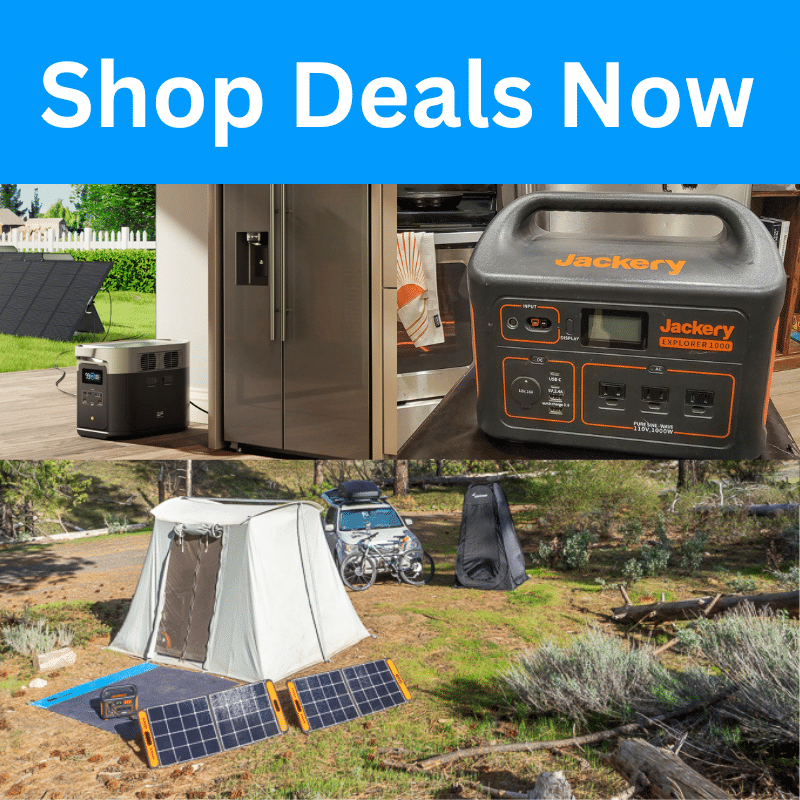I started Wifibum 2.5 years ago.
It lost money the first year.
Now it funds all my outdoor gear and travel expenses.
Starting an outdoor lifestyle blog is not a rich quick scheme, but it does have some unique benefits over time.
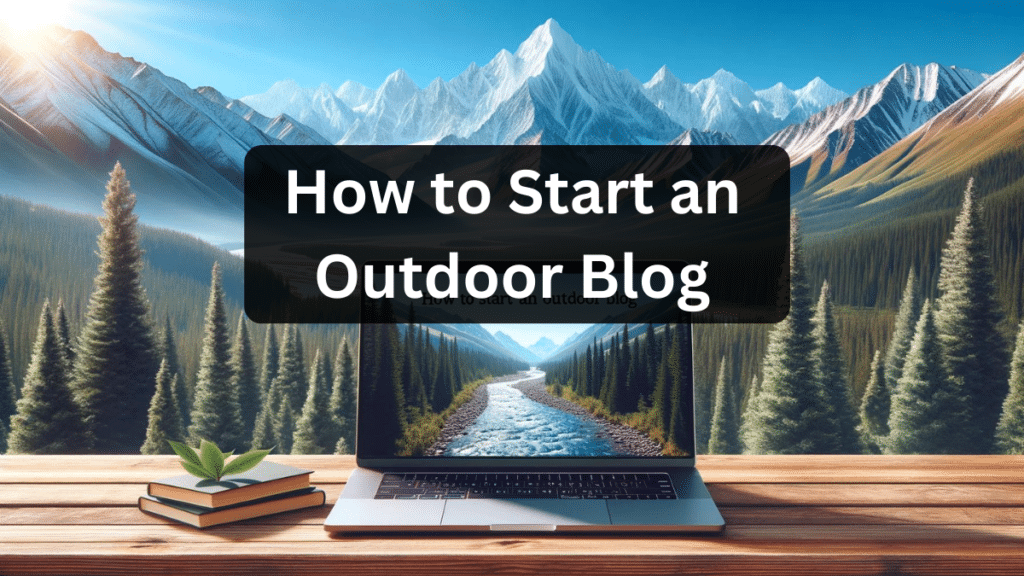
- Starting an Outdoor Blog to Fund Your Gear
- Learning New Skills
- “Business Expenses”
- How to Start an Outdoor Blog
- Questions You May Have
Enjoy the memes!
You Can Make Money to Fund Your Hobby
Blogging and creating content for “passive income” is a myth.
Making money takes hard work, time, and a bit of luck.
Year 1 of Outdoor Blogging
You probably won’t make money your first year if you’re a true beginner. While you should see your first dollars come in, it will probably lose money after hosting and other expenses.
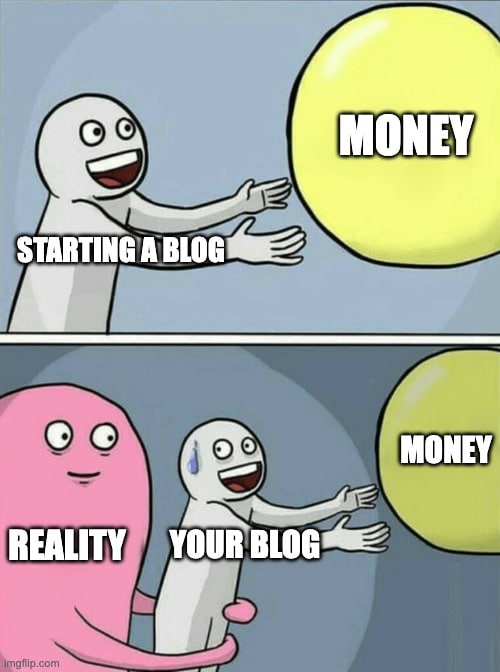
Expect to put in 100s of hours with no financial return.
Within a few months, you should start seeing some wins.
Expect traffic to trickle in at an astonishingly slow rate.
Year 2 of Outdoor Blogging
In your second year, $10,000 is a realistic goal. Your hourly rate will finally be around minimum wage.
The beginning of year 2 and the end of year 2 should be drastically different if you’re on the right path.
And once you start making ~$500 to $1,000 per month, you can reinvest your earnings into hiring writers and editors or building traffic in other ways.
Year 3 of Outdoor Blogging
In year three, $20,000 to $50,000 is an ideal goal, depending on how much effort you are putting in and the skills you’ve developed.
At this point, you should be able to start ranking for more competitive and valuable keywords.
You can start negotiating better affiliate commissions, apply for better programs, and earn more money without increasing traffic.
The growth curve for many sites looks like this:
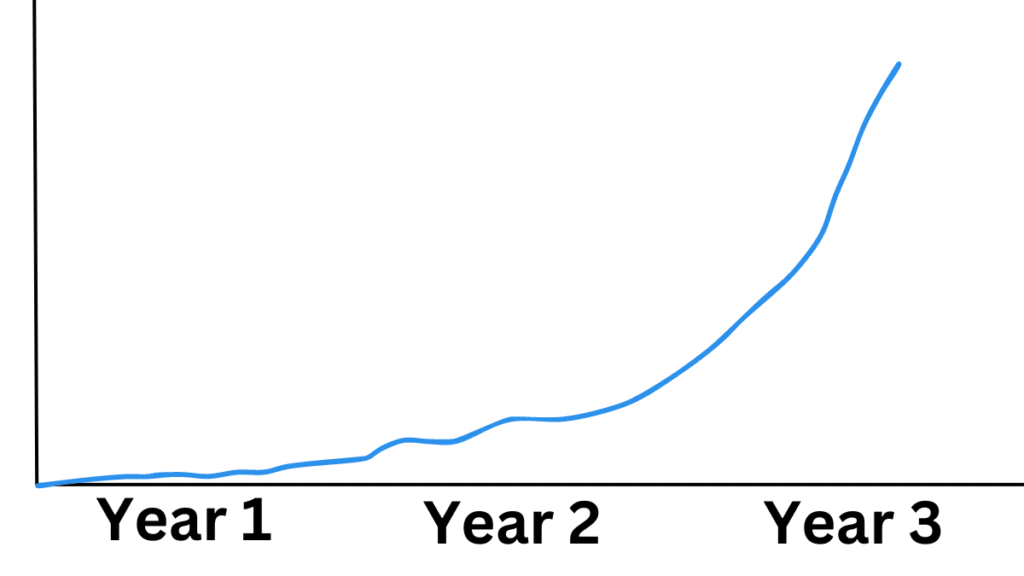
Important note: This is based on my experience of following many bloggers building in public. Wifibum is a much more choppy line because it’s not my primary side hustle. In addition, Google Updates can cause large, unexpected spikes and drops.
You Will Learn New, Valuable Skills
Bootstrapping a website requires you to be a jack of all trades.
I love learning new things. Having a website to test new skills and ideas is rewarding.
Throughout building several websites and working on other side projects, I’ve learned the foundations of various skills.
And while I’m not particularly great at any of them, they’ve all helped make me money:
- Copywriting – writing to persuade or take a particular action (could be as simple as getting someone to read your entire article)
- Basic Video Editing – Using Adobe Premier to edit a few YouTube videos for this channel and others.
- Lightroom – basic photo editing to make photos look better
- Canva – learning how to create basic infographics to make more interesting content
- ChatGPT4 – becoming a daily user of ChatGPT has made me more efficient. It designed my entire homepage – all the HTML and custom CSS code was built with zero coding experience.
- Python – I created the Power Station Finder App in 2 weekends with ChatGPT4. I had zero knowledge of any coding language, including Python, before I started. Now, I understand the basics and can make slight tweaks when needed. It’s also a useful tool.
- Email Marketing – Learning how to use ConvertKit to build a valuable email list. Creating automations and sequences depending on where users sign up.
- Search Engine Optimization – Learning how Google, Bing, and other search engines digest and rank content is valuable for blogs and e-commerce websites.
And while social media could (should?) be on the list, I use it sparingly. If you have a social media following, it will help drive results faster (cough, helpful content update, cough).
Business Expenses, Free Products, New Relationships
One of the best things about having an outdoor lifestyle website is being able to write off various expenses.
This is not tax advice, legal advice, etc.
For example, I can buy a new canvas tent, use it, and then write a review. I will deduct that as a business expense.
Writing an article about the best campgrounds near Yosemite? Your trip is now deductible if that’s the primary purpose.
And as you start ranking in Google for certain articles, you will be contacted by various brands to test out their products and review them. I personally do not do this on Wifibum, but I have on other websites.
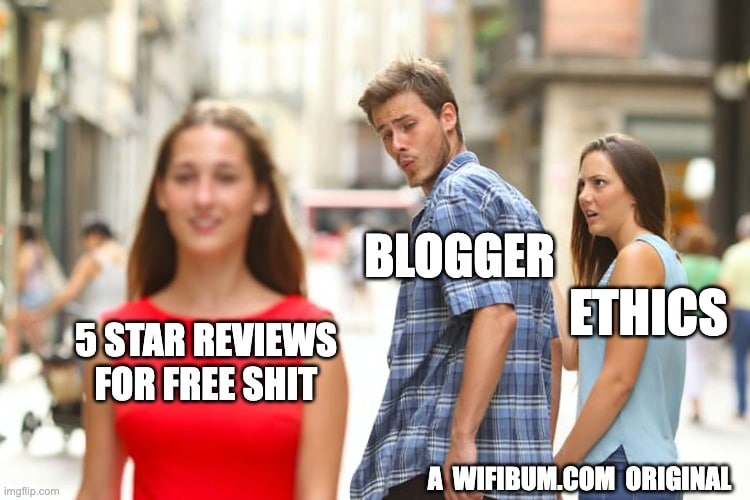
Lastly, your blog will start attracting like-minded people. They will reach out to thank you or try to connect. This can form unique connections or even future opportunities.
But What About AI?
While AI is changing the landscape of blogs and content websites, people crave content created by people they can relate to.
You should view AI as a tool to be more efficient. It can help you outline articles and edit them. It can help you create unique, proprietary tools that don’t exist.
I used AI to generate the featured image of this post (I wrote the text overlay). And while I wrote 95% of this article, I used it to rewrite a few sections.
You MUST have a unique angle.
I was the only person I knew working remotely from a canvas tent. So… I started writing about it.
It turns out, I used canvas tents, portable power stations, and other gear more than someone that camps once or twice per year.
I was able to demonstrate that in my articles through unique information and original photos.
Sure, AI can summarize and regurgitate my articles, but I believe people want to read real people’s opinions when it comes to their hobbies.
How to Start an Outdoor Gear, Hiking, or Lifestyle Blog
My 9 steps for starting a blog:
1. Choosing Your Blog Topic and Unique Angle
The barrier to entry is low for a blog. You need to have a unique angle. For Wifibum, the unique angle was working remotely while camping or in remote areas.
There are two ways I like to approach this process.
A) Think about what hobby you have expertise in
In reality, you don’t need to be an expert. You just need to be better than average, or better than current available information on the topic.
B) Think about a new hobby you’re interested in
People love to follow along on journeys. If you’re getting into a new hobby, start documenting your journey. Why you bought XYZ, how did it compare when you upgraded to a better quality XYZ.
I have started blogs where I’m interested in the topic, and I have started blogs with the sole purpose of making money.
The easiest way to have “grit” and “work hard” is to work on something you care about and are genuinely interested in.
Another tip is to niche down. Start very niche and expand when applicable.
Here are some example outdoor blog ideas for inspiration:
- Instead of writing about fishing, write about Tenkara fishing while backpacking.
- Topics: Tenkara rods, planning trips, best flies for various areas
- Instead of writing a general travel blog, become the expert for solo travel in XYZ country
- Topics: Is it safe to travel XYZ solo, best solo activities in XYZ, best gear for traveling XYZ
- Instead of writing about running, write about trail running gear and training for your first ultra
- Topics: Running vests, reviews of gels and snacks, training plans
I will be the first to admit, Wifibum is not a great example, but it still worked. My niche was TOO small. My first 20 articles were all over the place. Several have been deleted altogether.
Learn from my mistake!
2. Chose a Website Name that is Brandable
Come up with a unique name that is brandable.
Don’t pick “OutdoorGearReview (dot) com.”
I prefer short names, like Wifibum.
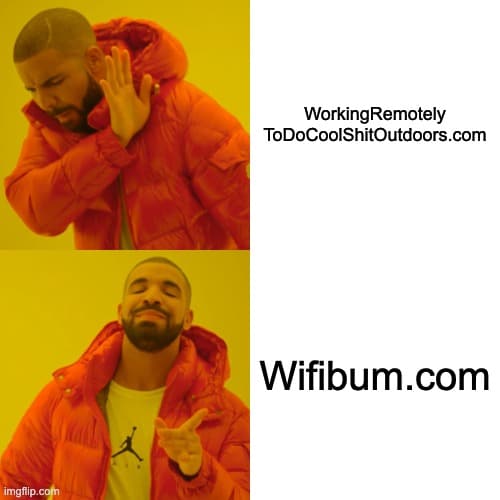
Having keywords in your domain name has become less important over the years. It’s perfectly fine, but don’t overoptimize.
General Tips for choosing an outdoor website domain name:
- Prioritize “.com” Extensions – The “.com” extension is the most recognized and trusted domain extension. Don’t go for “.info” or something goofy.
- Avoid Hyphens and Numbers – These can be prone to typos and are hard to remember.
- Memorability is Key – Aim for a name that is short, simple, and easy to remember. Avoid complex words or phrases that are difficult to spell.
- Stay Clear of Branded Keywords – If a keyword or phrase is closely associated with another brand, it’s best to avoid it. Not only can it lead to confusion, it might also result in trademark infringement. Many brands will send you a cease and desist if you use their brand name in your domain name.
- Relevance is Important, but Not Necessary – There are so many websites in 2023 that I think it’s more important to have something memorable than having a specific keyword in your name.
- Consider Future Growth – I liked Wifibum because it’s pretty vague and the “bum” part gives me an out to be a “bum” about anything outdoors. Even if you’re going to start writing about Fly Fishing, maybe avoid “Fly Fishing” in the domain incase you change the type of fishing you want to write about.
- Research Potential Names – I bought Wifibum.com before doing any research. I would have realized several social media channels did not have that available. Even the domain name was previously used. I was lucky that it was not used in a spammy way in the past. Check the Wayback Machine to determine if your domain name has been used in the past. Make sure it wasn’t used for spam. Google and other search engines may have manual penalties and other old ‘notes’ on the site that you can’t overcome.
Using ChatGPT is a great way to come up with domain names. Ask it to give you outdoor brand names that are easy to remember, short, etc. Try alliteration or other tricks to get it to give you unique ideas.
After I choose a potential domain name, I like to “sit on it” in my mind for a few days and make sure I still like it.
Once you settle on a name, grab the Instagram, Youtube, Pinterest, and other social accounts for it.
3. Hosting Your Website
Hosting will be your biggest cost when starting and outdoor blog. Some platforms require you to purchase 12 months at once. Otherwise, they jack up the price if you’re paying monthly.
I recommend committing to a year. It will also save
you the headache of having it not renew accidentally each month if you’re not on autopay.
You’ll find people who love and hate every single domain hosting platform.
I use BlueHost and SiteGround for my sites.
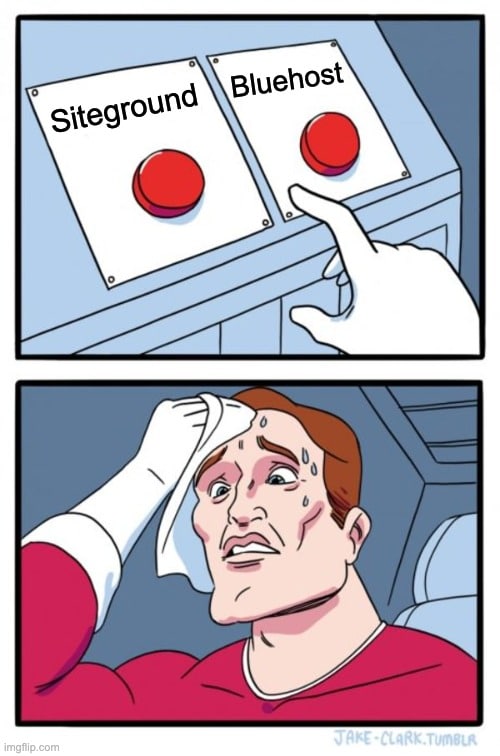
At the moment, I would recommend SiteGround because my ecommerce website that uses it is never down. Wifibum, which uses Bluehost, seems to have an issue once every month or two.
4. Installing WordPress and Choosing Your Theme
Nearly all hosting providers will have a one-click WordPress installer. WordPress is the best blogging platform and powers over 40% of the Internet according to Kinsta.
Once you install WordPress, you will need to choose a theme. I’m using a theme called Carbonate, which is no longer being sold. I’ve also customized it, so it’s not exactly what I would recommend to beginners.
If you’re just starting out, start with Generate Press. They have a free version which will get you started right away.
5. Must-Have WordPress Plugins to Help with Outdoor Blog
Plugins are little add-ons you can install on top of WordPress to perform a specific function.
The first plugins I install on any fresh WordPress site are:
- Yoast SEO – a Search Engine Optimization tool that helps you better rank your content by giving you feedback. It also creates automatically updates your sitemaps.
- WP Rocket – helps with speed and performance
- Imagify – Reduces image file sizes so that it doesn’t slow down your website.
If you’re comparing products, I use Lasso to make pretty displays.
6. Create Basic Pages: About, Contact, Privacy, Disclosures
There are fundamental pages you should build before publishing.
Creating your About page
I like to start with the about page. Take a look at your favorite blogs for inspiration. There are two types of people that go to your about page:
- Those who want to make sure there’s a real person behind the website (ie: can they trust it?)
- Those who are a fan of your content and want to know more about you, follow you, etc.
Contact Page
For similar reasons, I create a contact page right away. You can create an email address like “hello@yoursitename.com” within your hosting account.
Boring Stuff
Lastly, and the most boring ones, create a privacy policy and disclaimer page. These can be found online and edit them from there.
When you’re first starting off, you technically don’t need a disclosure. But as soon as you start accepting affiliate commissions or other types of advertisements, it’s good to have it set up.
7. Setting Up Google Analytics
Google Analytics is the standard for website metrics. It will tell you the number of visitors, page views, time on pages, etc.
Google has a simple guide to setting it up.
8. Do Basic Keyword Research
Keyword research and ranking articles is a never-ending skill to learn.
You need to do keyword research to avoid writing into the abyss. Avoiding keyword research is fine for a personal blog, but if you want to make money eventually, you must write about topics people are searching for.
The difference is as simple as writing “Top 10 Dog-Friendly Hikes in Utah” instead of “My Favorite Hikes with Fido.”
Here’s a quick overview video
I recommend trying to find 10 ideas for articles in 3 general categories.
If I was starting a trail running blog, I would start with something like this:
Category 1: Gear Reviews
Shoes, vests, socks, GPS watches, etc
Category 2: Trail Reviews
Best trail running trails in [insert your local area], [your state], etc. Planning trail runs, mapping them ,etc.
Category 3: Training & Technique
Training plan for XYZ Race, uphill running techniques, downhill running techniques, etc.
Note: topics considered “Your Money (finance), Your Life (health)” by Google are harder to rank for without trust signals (ie: links from other sites). Tread carefully on topics about nutrition/health without having quotes or sources from authoritative figures.
Once you have some ideas for keywords to write on that you have personal experience with, it’s time to finally start writing!
9. Write Your First 30 Blog Posts As Fast as Possible
I would try to knock out 30 blog posts, submit them to Google Search Console, 10 in each of your 3 primary categories… as fast as you can. Then you… WAIT.
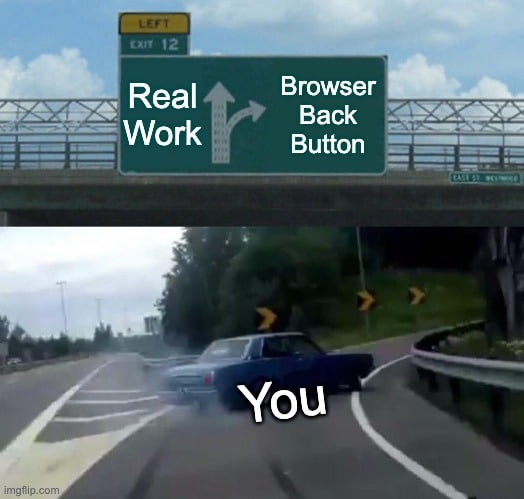
This is a LOT of work, but this is what you should focus on before designing a logo, sharing your website on socials, etc.
Aim for 800 to 2000 words each with 3 to 5 original photos per article. It’s okay to reuse the same photos when relevant.
Add links from one article to another when applicable (internal linking). This helps show search engines that your articles are related.
What NOT to Worry About
Don’t worry about getting them perfect. With several sites, I ended up deleting or heavily updating most of my original content as you learn more about writing in that niche.
Don’t try to monetize with any affiliate programs. Link directly to Amazon, REI, or wherever else when it makes sense. All good affiliate programs require you to have traffic and make sales within X amount of time.
Why This Approach?
In my experience, you will be surprised by which articles rank and which ones do not after a couple of months.
Some of your best articles won’t even show up in Google. One that you thought was mediocre ranks on page 1.
This is Google inviting you to write more on that subject and you’ll typically be rewarded with fast indexing and rankings.
And you’ll want at least 30 decent articles to get a general feel for how search engines view your website.
After that, it’s back to writing and publishing until you’re getting reliable traffic. If you have buyer intent keywords ranking (“best X for Z”), start joining affiliate programs and monetizing your traffic.
Questions You May Have
Do I need to be an expert to start an outdoor lifestyle blog?
No, you do not need to be an expert. However, you should have experience in the topics you write about. Here are my two general rules when I write on a topic.
- I should be more knowledgeable than the average person on the topic
- It should be helpful (or entertaining)
Sometimes, I write on topics to gauge the competition level and actual search traffic. This article you’re reading is one of those.
What About AI?
Become comfortable working with AI.
Use it as a tool to become more efficient.
Combining your blog with a YouTube channel or other social media is a solid strategy. If I had more time, I would have done much more YouTube for Wifibum.
Want to Learn More?
If this post gains traction, I will create a mini-series. I am not an expert, but not many write on SEO specifically for outdoor blogs, so I’d like to create a small community.
Already have a blog and want to work together? Email me at wb@wifibum.com.
